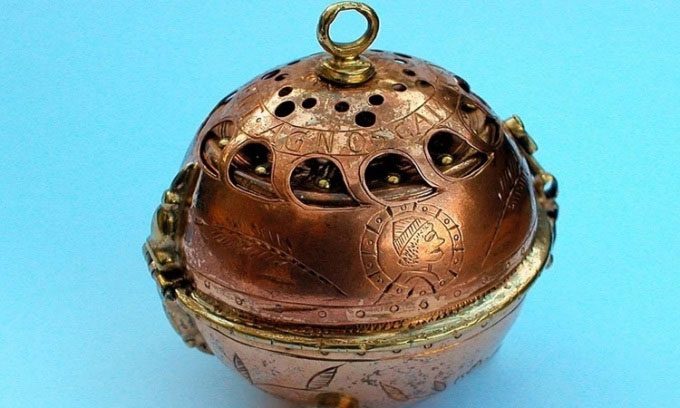The 1505 Clock: A Small Gold-Plated Globe Combining German Engineering and Eastern Aesthetics
In 1987, during a trip to London, an apprentice watchmaker stumbled upon a rare item in an antique shop. Hidden within a box cluttered with old metal trinkets was an intriguing clock. This small globe made of bronze was designed to open, revealing a smaller hemisphere inside. On the top of the hemisphere, a dial engraved with Roman and Arabic numerals could be found, characteristic of the famous clock designs that were highly popular in Germany during the 16th century.

The 1505 Clock is exquisitely crafted. (Image: Wikimedia).
Unaware of the significance of his discovery, the apprentice sold the clock, initiating a series of transactions that eventually led to the item falling into the hands of a private collector in 2002. At that time, the importance and reliability of the clock became clear. Known as the 1505 Clock or the Amber Apple Clock 1505, this unique artifact is believed to be the oldest working clock in the world, according to Amusing Planet.
The 1505 Clock is a handcrafted piece by the renowned locksmith and watchmaker from Nuremberg, Peter Henlein, who was one of the pioneers in developing small decorative portable clocks. These small clocks were often worn as pendants or attached to clothing, serving both decorative and timekeeping purposes.
Henlein was born and raised in Nuremberg. As the son of a blacksmith, he quickly followed in his father’s footsteps as a locksmith. At that time, locksmiths were among the few craftsmen skilled and equipped enough to enter the new field of clockmaking. In 1504, after a tragic accident that led to the death of a fellow locksmith, Henlein sought refuge in a Franciscan monastery in Nuremberg, where he lived until 1508. Behind the monastery walls, Henlein found an environment rich in scientific and astronomical knowledge. It is likely that during his time in hiding, Henlein gained a deeper understanding of clockmaking, even creating masterpieces like the 1505 Clock.
Researchers have identified five clocks produced by Henlein, which bear the date and his initials engraved inside. At that time, locksmiths were not allowed to inscribe their names on the objects they created, so the inventor cleverly hid his initials in a crude engraving that was less than a millimeter high, visible only through a large magnifying glass. In addition to his initials, Henlein engraved a line in Latin that means, “1505 – Time will elude us (Henlein), but I (the clock) will recognize time accurately.”
This clock primarily came to fruition thanks to Henlein’s ability to miniaturize the twisting pendulum and the spring mechanism to unprecedented scales, a remarkable technological achievement of the time. By transforming the clock into a portable timekeeping device that could be worn on the body, Henlein not only personalized the clock but also changed how people measured and managed time.
Throughout his life, Henlein created many clocks and devices, including a small drum-shaped clock known as the Nuremberg Egg. He also constructed a clock tower for Lichtenau Castle in 1541 and crafted various sophisticated scientific instruments. Only two amber apple clocks exist in the world today. One is the 1505 Clock, which is part of a private collection, while the other is the Melanchthon Amber Apple Clock, owned by the Walters Art Museum in Baltimore since 1530.




















































